“I don’t think many readers have really understood what I set out to do with The Assault on Culture. My principle concern was actually with the construction of histories, the process of historification, the fact that no matter how much attention is paid to detail; the construction of a history is always a process of radical simplification which grossly distorts the subject under discussion.”
Stewart Home interviewed by Fabio Zucchella in Pulp Libri #3, Rome September/October 1996.
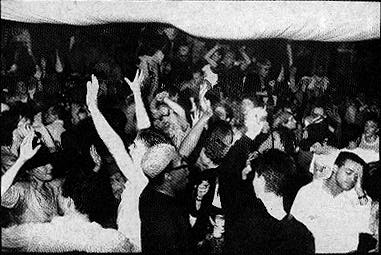
If you read most of the books about acid house you are presented with a tale of energy, excitement, hedonism and positivity – a revolution taking place in our lifetimes which may yet rival the 1960s. Bleeps and pills heralded a new era in culture, with the nation’s youth rising as one to put their hands in the air – only challenged by the tabloids and cops.
Well I’m not about to dispute that, but it seems that the arrival of acid house wasn’t greeted with universal acclaim in all quarters.
Exhibit A
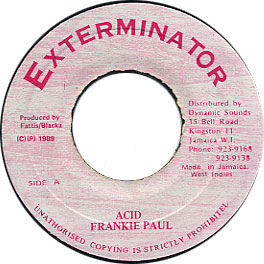 Frankie Paul – Acid (Exterminator 7”, 1989)
Frankie Paul – Acid (Exterminator 7”, 1989)
On first hearing, this is another wonderful example of “trend jumping” in reggae, with whatever is in the news turning up on records the next weekend:
“Well I took a trip down to London town
To hear the talk wi a go round
At the new stylee – 89 click
Click of the century
Dem talk ‘bout aciiid
Dem a dance aciiid”
Frankie Paul leaping on the bandwagon and describing acid as a new dance, alongside yard staples such as “jump and spread out” and Water Pumping etc. The area of dance crazes following hit tunes in JA culture is really under-exposed, although it had an overground resurgence with Sean Paul’s Like Glue recently – the video and fold-out sleeve for the 7” both giving step by step instructions for all you dancehall queens out there.
However all is not what it seems – later choruses in the track proclaim:
“Aciiid – don’t you dance the aciiid”.
So – what up, Mr Paul?
Exhibit B
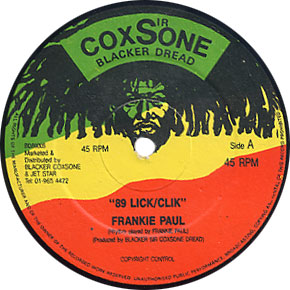 Frankie Paul – 89 Lick/Click (Blacker Dread 12”, 1989)
Frankie Paul – 89 Lick/Click (Blacker Dread 12”, 1989)
89 Lick is essentially the same riddim – with added anglicised lyrics (Blacker Dread being based in south London, whilst (E)xterminator runs out of Kingston). So the dances now include “breakdance” in addition to Water Pumping and a reference to watching Channel 4 gets thrown in as well! Plus:
“I know a girl, she’s from Brixton town
Every time I see her she always wear a frown
…She a dance aciiid”“Jamaicans talk about jump and spread out
English talk ‘bout aciiid”“Dennis Brown he don’t like no acid
Frankie Paul he will never try no acid”
It’s kind of light hearted, with an anti-drugs message lurking somewhere in the background, I guess. The sort of thing you might expect someone to come out with if they had just just blown into town for a few days and experienced the explosion of “the 2nd summer of love”™, perhaps.
Exhibit C
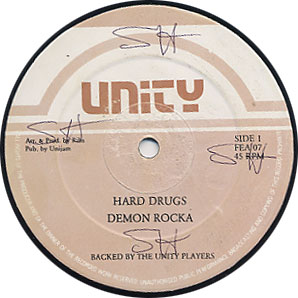 Demon Rocker – Hard Drugs (Unity 12″, 1989?)
Demon Rocker – Hard Drugs (Unity 12″, 1989?)
Since the excellent Honest Jon’s retrospective Watch How the People Dancing we are all obliged to refer to “the collectible Unity Sounds label”. At least you get that impression from ebay.
Unity, for those who haven’t got the compilation, is one of the key points in the evolution of the London (and hence UK) reggae soundsystem scene. It’s all dealt with superbly in the sleevenotes to the comp, so I shan’t bother getting too deep into the history here. For our purposes it is worth remembering that Unity were one of the first (if not the first) crews to start producing their own digital riddims in the wake of “sleng teng”. Indeed, because of their connections with Jammys, they were also one of the first UK sounds to play sleng teng.
Here you have a sound which has been playing digital dance music since 1985, and releasing its own twelves for a slightly shorter period. This gives them a good 3 years jump on acid house. So obviously the arrival of the loved-up 808 massive with the smiley bandanas is welcomed with open arms, no? Well…
“Now dis one dedicated to all the yout dem wi a take dis acid ting
We no love it – we fight against it, it bad bad bad”[chorus] “some a holla fi de drug and when they get it can’t manage it”
“Now de acid business come a kill de yout dem
me a warn all de nice young people dem”
A lot of the Unity tracks which didn’t make it onto the compilation have a very strong and occasionally discomforting moral tone to them, so it’s not that much of a surprise to hear that Demon Rocker wants the youth to be taking sensi and not LSD, or that ecstasy is “a mind bending drug”.
What’s compelling about this tune is the way that Demon Rocker (aka Demon Rocka and Deman Rocker) explicitly adopts the ancient role of the folkloric storyteller. The lyrics are a complete linear narrative and there is a crystal clear moral to the story. It revolves around Demon’s experiences of his mate Mark who gets a new job, becomes a yuppie and invites him to a party up in Finchley (of all places!). Great party: “white and black dem a mingle and have a good time”.
But wouldn’t you know it:
“Next thing a man come in with a pouch pon him side
Everyone start rush him from back and side
Me feel him must be someone everyone like
But him a sell ecstasy – 25 pounds a time”“Them a start play some music me never hear in me life
and put on some big bright flashing lights
People start shout ‘acid!’ at the top a dem voice
When me see certain thing me eyes open up wide”
And indeed the rest of the tune descends into drug-fuelled debauchery (admittedly with a probably conscious sense of the ridiculous): it’s a catalogue of public sexual acts, people bringing their bicycles inside and riding them around, fighting, women showing their arses, and men dancing with one another. Now for some people, that might sound like quite banging night out (or indeed an ordinary Wednesday night in), but that is not The Way of the Righteous:
“So me tell all de yout no take LSD
and keep your backside out a acid party”
What is most interesting for me is not the initial impact of acid house on a vibrant, electronic, ganja-fuelled dance music scene, but the two trajectories of these attitudes and activity in the following years.
Firstly, the UK roots scene, which has (let’s face it) rarely been a launchpad for futurism or innovation, was pretty slow to catch on to the babylonian un-ital digital riddim.
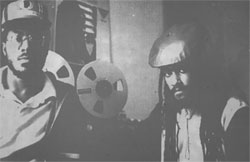
The track which gets credited for shaking everything up (in all senses!) is Warrior Stance by Bedford’s Dread and Fred. According to the Rough Guide, this actually came out in 1988 as a 12” on Jah Shaka’s label, which is impressive if you think about it in terms of acid house, but a bit of a lag in reggae terms when you consider sleng teng and its various precursors. (Though I’m sure Shaka caned it on dubplate for ages before its release.)
Apparently there were serious mixed feelings amongst the cognoscenti about the arrival of Warrior Stance and the tracks which followed it. In some ways the purists were right to be nervous, because a load of producers such as Iration Steppas saw to it that UK Roots would never be the same again.
And it wasn’t just the music, either – people felt that the message was subtly shifting away from rastafari – into a void:
“I’m kind of disheartened with the roots now, because when you’re talking about roots, you’re talking about rasta music. If you’re talking about dub that’s fine enough, but to me dub is just the rhythm, but roots is the message and without a message there is no vision. […] now I find the roots scene in England is turning more to the dub and away from the roots. You’ve got a lot of sound systems claiming to be roots sounds, and they’re not defending what they’re saying. […] It’s also become a freak kind of thing, when I see people who are the overspills from the acid dances and gothic people, and I know none of them are in it for the message, none of them have any love for my faith. They’re in it for the dub, so it’s now become another form of rave – you go to an acid dance and hear this thumping bass, well let’s go to Jah Shaka now and hear another kind of thumping bass, you know?”
Danny Red, interviewed in Boomshakalacka #11, October 1992.
This criticism exists to this day, with the University of Dub dances at the Brixton rec particularly coming in for flak because of its audiences’ alleged ecstasy/coke use, whiteness, and general unrighteousness. Obviously this ignores the role that these dances play in bringing a message to people who simply haven’t heard it yet. No doubt there are countless ex-ravers (and possibly even some ex-goths!) who followed Shaka’s thumping bass into a whole new world of reggae music.
On the other hand, we have to consider the (massively under exposed) subsequent trajectory of the Unity Sounds crew and Demon Rocker himself:
“Demon Rocker and Flinty, they went off to be the Ragga Twins, Speccy the Navigator went into the rave scene, travelling all over the world, he’s still doing it now [I have good grounds to believe he is the excellent MC Navigator these days – JE]. Peter Bouncer worked with Rebel MC. They all worked for one person at one stage, Shut Up and Dance I think they called themselves. I thought these guys made it their duty to come to our dances, taking whosoever was on the sound and going off to record them on something else”
Robert Fearon aka Ribs, Unity Sound, interviewed by Honest Jon’s for the sleevenotes to Watch How The People Dancing (Honest Jons HJRCD3 2002)
In some ways, people had to wait for acid house to run its course for all the links to be made. ‘Ardcore allowed the dancehall crews a way in to rave, and the ravers a way back, into dub, reggae and dancehall.
There’s scope for much more on all this – the dialectical relationship between hedonism and righteousness in the London dancehall scene, the role of technology and drugs, the furious importing and exporting of beats and styles. Somewhere there is a book to be written on the role of Saxon, Jah Tubbys, Heatwave, Jah Shaka, Unity and countless others in the ‘ardkore continuum.
Prices of old records being what they are, it’s unlikely that I will be the one to put anything cohesive together, but I hope you’ve enjoyed reading this as much as I’ve enjoyed cramming another piece into the jigsaw. There is always another story to tell, which is why I am wary of historification as a process. Fortunately, in the blogosphere and elsewhere, there is always someone willing to tell another story and I await the next chapter with much interest…
Thanks to Danny and Tim P.
Since publication, this article has been kindly referred to by:
Anthony Iles and Eve Lear in their piece Media, Secession and Recession (cesura-acceso)
Ornette in his piece on X Amount Crew’s – “can’t do it alone” [unreleased, 1993] (blogtotheoldskool)
martin ( / )
Brilliant piece! This particular bit made me crack up laughing
And indeed the rest of the tune descends into drug-fuelled debauchery (admittedly with a probably conscious sense of the ridiculous): it’s a catalogue of public sexual acts, people bringing their bicycles inside and riding them around, fighting, women showing their arses, and men dancing with one another. Now for some people, that might sound like quite banging night out (or indeed an ordinary Wednesday night in), but that is not The Way of the Righteous:
2004/06/17 @ 02:10 pm
matt b http://wretchedmatt.blogspot.com/
that’s not ridiculous! a number of years ago we had a party and one of the highlights was someone drunkenly riding a bike in our cellar.
2004/06/17 @ 03:13 pm
John
Did anyone show off their arse, tho Matt? We need to know! And here was me thinking I’d be in for some choice reminiscences about pre-SUAD stuff! I should have known… 😉
2004/06/17 @ 05:05 pm
Stelfox
The best and most interesting thing I’ve read on a blog in months. sterling work, john. thanks. (course, i have to rip my blog up and start all over again now!)
2004/06/18 @ 11:20 am
disco dave
excellent, knew a bit about the lineage between ragga and acid house, but not the details provided here – thank you
2004/06/19 @ 09:17 am
mms
thats wicked –
that dillinger album cocaine was released around the same time i recall – displaying an “acid house mix” of cocaine
haha
2004/06/23 @ 02:16 pm
Ali
@ dominic: dr alban – no coke
2004/07/09 @ 12:23 pm
Dominic
“excellent piece . . . . i used to listen to this radio show called “hillbilly house” in hartford, connecticutt, usa. 90/92. some of the best tracks the host of the show played were uk rastafarian anti-drug polemics. “don’t want no coke, no heroin, no hash hash, no amphetamine.” wish i knew the names of these songs, as i’d probably be willing to pay lots of money over (sucker). . . . obviously ragga twins had a lot anti-drug lyrics . . . . in short, excellent post
2004/06/29 @ 03:23 am
how will you sing those other songs
great piece, growing up in Dublin with all the pirate stations we’d get back to back roots reggae shows followed by “rave” shows – i do recall the show by “john public” ending with Max Romeo “chase the devil” and the following show “the sweatbox” beginning with the prodigys “outta space” which sampled rather well the Max Romeo “send into outta space to find another race”..
I’d no idea about the ragge twins but it makes perfect sense – also had the pleasure of seeing flinty and badman perform to about 100 people in Dun Laoghaire at the Boylan Community Center – yeah the venue was as drab as it sounds – but the crowd loved it.
Then again i also remember being in london at a “dancehall” party in 1990 and that awful “Girlie Girlie” (“flash it round the worldie”)” was the “big tune” of the night??
You have your skeletons london!! 🙂
for dominic: “don’t want no coke, no heroin, no hash hash, no amphetamine.” – check out The Bush Chemists “Drugs is a Ting” – not the track you’re looking for – similar but in a big UK roots dub style
Pingback: UNCARVED.ORG BLOG » BLOG ARCHIVE » REGGAE REGGAE REGGAE
Pingback: SHARDS, FRAGMENTS AND TOTEMS: GRIEVOUS ANGEL’S ALTERNATE REALITY OF RANDOM SCRIBBLING
Hey,
You all seem to know a lot about acid house. I’m a dutch student and i’m doing research about it for my school.
Are you still interested in this kind of music, are you still going to these parties? If so, can you tell me the names of these parties or the clubs.
I’m trying to find somebody in england who i can interview for my study.
Thanx a lot,
greetz roos
Pingback: UNCARVED.ORG BLOG » BLOG ARCHIVE » PLAN B MAGAZINE